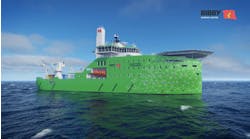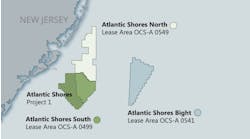Contributed by Gudmund Olsen, AGR
The sprint to reach net zero by 2050 is putting more impetus on offshore carbon capture and storage (CCS) initiatives to tackle emissions from heavy industry and remove carbon from the atmosphere. However, while recent progress is encouraging, according to the IEA, the planned pipeline of projects falls well short of delivering the 1.7 billion tonnes of CO2 capture capacity deployed by 2030 to keep in line with 2050’s net-zero targets. In the meantime, the groundwork to lower the cost of CCS while increasing the cost of unabated emissions continues to be disjointed internationally, despite the clear benefits CCS brings to climate change.
The global market for CCS is projected to be valued at $9.42 billion in 2026. Growing from a market value of $4.17 billion in 2020 and is projected to exhibit substantial growth at a CAGR of 15.7% over the forecast period. However, there are leaders and laggards in this burgeoning industry. To fulfil global ambitions, a strong, unified, commercial value chain is necessary to realize its potential as a practical and viable economic and environmental solution.
AGR, a multi-disciplinary engineering consultancy, is part of the LINCCS (Linking Carbon Capture and Storage) research project that is committed to solving storage capacity challenges in the Norwegian North Sea (Figure 1).
Over the next three years, the consortium aims to develop next-generation CCS solutions ready for demonstration by year-end 2024, with full-scale commercial projects expected to be finalized by 2027.
The company’s multidisciplinary teams will deliver support and advice on geoscience, reservoir and drilling engineering, storage monitoring, facilities and cost engineering to create an "atlas" of the design and redesign possibilities across different scenarios.
Balancing risk and reward
While the urgent need for offshore CCS is widely understood, there needs to be a broader acceptance of the technical, financial, geological and environmental risks at stake. Like any industrial process, it is complex and not without risk. A critical evaluation of the complex geology that each site presents is paramount.
In efforts to displace oil and achieve enhanced recovery, dense phase CO2 pumped into porous saline aquifers and stored in reservoirs next to oil and gas fields, has helped the industry for many years. However, over time, the CO2, which has not been dissolved in the aquifer water or trapped in pores, will move upward along permeable conduits/reservoirs (since the dense CO2 phase is more buoyant than water) and become a potential hindrance. Until it is capped by a geological seal, this may creep into reservoirs and invade hydrocarbon-bearing intervals. In the long-term, CO2 will be dissolved and may react with minerals in the host rock to reach a solid state.
Monitoring CO2 plume migration via seismic technology will control such an event. However, storing CO2 in a trap, similar to an oil and gas accumulation, or to allow it to percolate a saline aquifer, is a strategic choice. In the latter case, there is less risk of top seal failure, compared to the accumulation of a CO2 column that builds overpressure by buoyancy.
While it may be tempting to store CO2 in a drilled location, where the geology is well understood, legacy wells pose a threat of overburden integrity and containment. Therefore, when screening for storage—usually via 2D or most likely 3D seismic—calculating the cost on the bottomline, as well as the environment, is vital before a reservoir can even be qualified. With such high stakes, failure caused by for example fault leakage is not an option.
The LINCCS project will also investigate the feasibility of reusing existing infrastructure. For instance, redesigning injection wells for CO2 storage in a simpler and more cost-effective way compared to a conventional oil and gas well, which may encounter significant corrosion issues, for example. Evaluating the potential of cutting carbon emissions on platforms, shipping and through transportation is also an aim of the consortium. Integral to the venture is sharing insight and intelligence to scale larger endeavors.
Changing the CCS mindset
CO2 storage needs to be more cost-effective and standardized before it will become more widely adopted across the entire supply chain. While the North Sea is a front runner in the global race to store CO2 offshore, international efforts are required to agree carbon pricing, instill incentives and enhance knowledge to mitigate risk.
One of the most recent CCS developments underway in the North Sea is the construction of an offshore, 1,000-km CO2 export trunkline that will connect an onshore CO2 transmission infrastructure in Zeebrugge, Belgium, to a storage site under the seabed in the Norwegian Continental Shelf (Figure 2).
The project by Equinor and Fluxys could link neighboring hubs, further increasing the geographical reach of the project across North West Europe. The offshore pipeline is planned to have a transport capacity of 20 million to 40 million tonnes of CO2 per annum, meeting an emerging need for CCS from multiple European industrial players.
Likewise, it’s hoped the UK’s first carbon storage licensing round, which closed in September, will spur action to generate a commercial value for CO2 by reducing cost and increasing competition among CO2 storage license operators. Thirteen areas—made up of a mixture of saline aquifers and depleted oil and gas fields—were up for grabs (Figure 3).
While the areas on offer have a close proximity to existing infrastructure suitable for repurposing, as well as links to industrial clusters aiming to decarbonize, it is the license-seekers ability to conform to the geological and judicial conditions, which make or break a bid.
Alternatively, to encourage carbon storage and stimulate a carbon economy, CO2 can be commercialized through enhanced oil production (EOR), a common and successful practice in the US. By injecting CO2, instead of water, into existing wells to extract hydrocarbons, CO2 can be permanently stored under the seabed. This not only reduces the carbon emissions from the last drops of remaining oil, which can be very high, but also enhances the recovery of oil from mature fields. In turn, this reduces the need to develop new fields or build new infrastructure to meet energy demand while accelerating the development of infrastructure for future CO2 storage that will dramatically reduce emissions.
From here, there is huge potential to not only establish a value chain for storing CO2 going forward, but also to bring this together with the creation of offshore energy hubs. These hubs will serve as connecting points and storage sites for the energy produced with offshore renewables.
The time is now
According to the Global CCS Institute, there are 27 fully operational CCS facilities with 135 in the pipeline from a diverse range of sectors, including cement, steel, hydrogen, power generation and direct air capture.
To safely store CO2, it has to make sense economically. Carbon’s current value is currently not high enough to pay for the entire value chain. While innovation will drive a more standardized, efficient and sustainable industry, it is investment that will turn intentions into a viable industry to reduce carbon emissions.
About the author: Gudmund Olsen is the manager of reservoir engineering with AGR.







